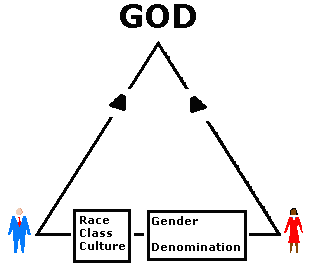
Presented at Trinity Fellowhip on 08/13/2000
In our series of sermons on the Lord's Supper we have seen it as a symbolic meal that we eat, as a covenant that we ratify ("the new covenant in His blood"), and as a witness that we give (as we "show forth the Lord's death until He come"). But this does not exhaust its meaning. For Paul uses the meal to symbolize not only the Body of Christ that was broken for us, but also His Body that remains in the world: the Church. As we partake of one cup and one bread (literally, "one loaf"), so we all belong to one Body, the Church.
What does the "sharing" mean in vs. 16? Our Roman Catholic friends take this very literally, along with the Lord's language at the Institution of the meal, believing that when He said "this is my body," He meant it literally, so that the Bread and Wine literally transform into His actual body and blood. Protestants interpret that language metaphorically: the elements represent His body and blood. How can we tell which interpretation is correct? By taking our stand alongside the Disciples in the Upper Room and asking what the words would have meant to them when they first heard them. Would they have been in any doubt what was the actual Body of our Lord? No. The Hand which gave them the bread was His body. It did not break or bleed when the bread left it and went to them. They would naturally have understood the words of institution metaphorically. And so they were meant. Therefore, the word "sharing" in vs. 16 refers to our identification with Christ in His death and resurrection: the death He died is the one we should have died, so we share in the death vicariously and in its benefits directly.
In vs. 17, we identify not only with Christ in His death, but also with His Body, the Church, which shares with us in that death. Thus sharing the elements symbolizes participation not only in His sacrifice but also in the unity of the Church. That unity is found in our common Savior and Lord, in the common Gospel through which we came to put our faith in Him: in other words, the sharing of vs. 16 is what creates the unity of vs. 17. We are bound not by a common culture, race, class, style of worship, or set of human traditions, but by our common salvation in Christ. And yet, as we look at the Church today, it seems to find its unity precisely in all those lesser things. That is what determines who is together. It was in the 60's we first noticed that 11:00 AM on Sunday morning was the most segregated hour of the week. This has not changed much since.
We see then two people separated by race, class, culture, and other barriers. These barriers are too thick and high to be bridged by human effort alone. But imagine that above them is a single point, representing Christ. They are joined to that point by two lines reaching up from the one between them, forming a triangle. As long as they walk by sight and not by faith, they can see only the barriers between them on the horizontal plane. But if by faith they perceive the vertical dimension, if by faith it is actually more real and more important to them, then by moving closer to Christ they also move closer to each other, rising above the walls that separate them. And that is the only way they can do so.

This unity of the Church in one Lord and in a common interest in His sacrifice demands both a separation from the world and a commitment to each other. We are one in contradistinction to something else, i.e., the world. "Separation" has gotten a bad name from Fundamentalists who practiced an unbiblical "secondary separation," who confused separation with isolation (contrary to 1 Cor. 5:9-11), and who superficially defined it in terms of small lists of "worldly" pleasures to be avoided ("I don't drink, smoke, cuss, or chew / And I don't go with girls that do. / I don't play rock or go to movies; / I don't do anything that groovy!"). But, nevertheless, separation is a biblical command (2 Cor. 6:14-7:1) which flows from the Church's unity in Christ. We must be willing to be different from the world, as individuals and as a Body. This explains the connection between Communion and Church Discipline: Non-Christians and professing Believers who are living like non-Christians are not to partake, lest they be guilty of perjury. We are not to take the world into the Church without converting it, nor are we to allow Believers to live like unbelievers and remain as members in good standing. So exclusion from the Table is the ultimate expression of that discipline when refusal to repent makes the tragedy of excommunication unavoidable. And there is an undying commitment to all who find their unity with us in Christ, setting aside more petty differences for the sake of His Gospel and His glory.
It is best then, when possible, to start with an actual unitary loaf rather than a pile of already separated wafers, so that we do not lose an important part of the symbolism and message of Communion. And our sharing in that one loaf should remind us that we share in one Body, and that this sharing demands separation and commitment. Let us then share together once again, with a greater appreciation for what the Apostle meant when he said, "Since there is one loaf, we who are many are one Body; for we all partake of the one loaf."
Here endeth the lesson.
Dr. Donald T. Williams